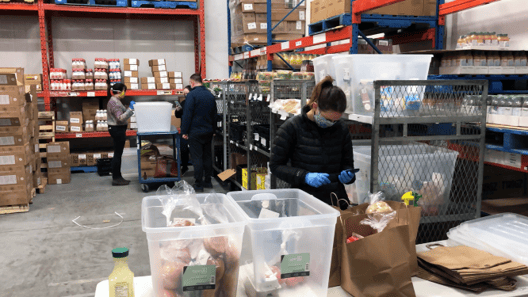Pivoting Your Supply Chain: Tips and the Benefit of Technology
In previous weeks, we’ve given overviews of supply chain topics like warehouse optimization. This week, we’re elaborating on pivoting from B2B to B2C, or combining both types of operation in one warehouse, and how our supply chain technology can help.
Key Takeaways:
-
To successfully pivot from B2B to B2C, you may need to implement more customer-facing resources and appoint a team member to lead the transition.
-
On the technology side, using software to optimize space, track inventory, and optimize routes can save your team time and enhance accuracy as your business pivots.
Combining B2B and B2C Operations In One Warehouse
LogisticsIT notes, “Whereas once it was largely the case of managing e-commerce on its own, companies are now recognizing that there is a real synergy in bringing B2B and B2C all under one roof. If you consider real estate costs and all the infrastructure that is required, it certainly makes more sense for many companies to do things this way.”
When it comes to making this shift, TradeGecko states: “Having a B2C customer database is advantageous for your business because it allows your company to create valuable direct to consumer relationships, gain customer insights and higher margins. It also creates potential to sell your B2C customers adjacent products and services. Unilever had the right idea when they acquired Dollar Shaving Club for $1 billion.”
Pivoting from B2B to B2C
While some companies may opt to combine B2B and B2C operations in one warehouse, others may choose to pivot from one to the other. Routeique supported Alberta-based food manufacturers and distributors focused on B2B to pivot to deliver to both B2B and B2C customers.
Through our continued work with AlbertaGrocery.ca, we have some specific advice for manufacturers or distributors looking to expand into the B2C space.
Tip #1 - You may need to adjust your customer-facing resources
We had to implement more customer-facing resources, including a website where customers can order. This website was based on the order portal we already had for B2B sales. However, if you are an organization that does not yet digitize your supply chain, you may find yourself having to create your website from scratch.
Tip #2 - Appoint a team member to lead the transition
Many of our clients and partners elected a champion to own the transition process. One person that could have an all-encompassing view to lead adjusting the processes, to ensure the transition ran smoothly. In other words, having a dedicated asset to help shift your processes from one to the other is ideal.
Tip #3 - Use the right technology
Throughout the process, we continue to use our Inventory Management System and our Delivery Management System apps to ensure accuracy and customer satisfaction. The right technology gives you the flexibility to provide the service level required for both B2B and B2C.
Warehouse management and delivery processes are similar for B2B and B2C, but interestingly we’re finding that our local partners and the AlbertaGrocery.ca team are configuring our technology differently each use:
-
The delivery photo and geolocation tracking is the most popular setting for proof of delivery. You can’t count on your B2C customers being home, and it provides a contactless delivery option.
-
Routeique clients have always relied on our route optimizer to factor in the service windows for B2B deliveries when recommending the most efficient route to their drivers. Those same customers are now using that feature to allow their B2C customers to choose what time their orders arrive at their front door.
-
The option to use the IMS app to perform a two-phase pick, moving products into a staging area and then loading by order directly onto trucks, was a common workflow. We’re now seeing the one-phase pick is more popular, with our clients setting up pick lines to pick & pack a higher quantity of much smaller orders into shipping units.
How Routeique’s Technology Can Help
As we noted above, using the right technology helped our team stay organized as we implemented new processes. Here are just a few key ways Routeique software can help streamline a busy warehouse:
Accurately Tracking Inventory
Real-time inventory tracking helps you ensure the items your customers need are in stock.
Our Inventory Management System's (an enhanced WMS) numerous features include the ability to track how much of a product you have in stock, and monitors changes based on the expected orders for that day or week. It even helps you schedule orders based on your average sale time, so you always have product when you need it.
Optimizing Space
B2B orders are traditionally larger and fewer, so the challenge with pivoting to include or to B2C is navigating how to manage a higher volume of smaller orders. We know with large orders moving in and out, space optimization is always a concern. One of our inventory management features' newest capabilities is the ability to suggest improvements to your warehouse layout by leveraging sensor data and machine learning technology.
Shipping Quickly and Efficiently
Experts suggest in a fast-paced warehouse, software with steps that mirror the physical processes (such as picking, staging, loading), can result in smooth handling of fast-moving orders.
We kept this in mind when designing our IMS app, which lets your warehouse team log every step of your pick and pack process, as well as claims, expiries, and more, to ensure you have all of the necessary details at any time.
This cuts down on errors such as shipping incorrect or expired products. Errors of this kind can result in significant costs related to shipping the item back, processing and restocking it, and re-shipping the correct item to the customer.
Ensuring the correct orders are shipped speedily also keeps your customers happy, which is critical for B2C operations: after all, 32% of all customers would stop doing business with a brand they loved after one bad experience.
Modernizing Your Operation
Digitization can also be extremely beneficial to your warehouse operations and supply chain as a whole.
One distributor interviewed in Supply Chain Brain stated that with a WMS, "We're pulling orders faster, and we can definitely keep track of what our pickers are doing all day." Other interviewees noted that everything from receiving to training new staff was faster with a modern software solution.
Despite these benefits, a recent IBM survey of B2B organizations discovered:
-
only 49% of companies were using an Enterprise Resource Planning system (ERP)
-
only 38% were using a Warehouse Management System (WMS)
These stats might suggest that adopting the right technology can put you ahead of competitors; however, experts are also clear that technology will only become a more critical and popular solution in supply chain and warehouse management. When this is taken into account, adopting a WMS/IMS becomes more of a "need to have" than a "nice to have."
Additionally, it's essential not just to adopt a WMS but also to use it to its fullest capacity and integrate it into your processes.
Our clients also take advantage of our vendor management, order management, and warehouse optimization processes to create a fully optimized warehouse.

Learn More
Routeique’s Inventory Management Solution is an ideal option for warehouses of all sizes.
Interested in learning more? To contact our team, get in touch at info@routeique.com.
For regular updates on what we’re working on and the latest supply chain news, you can follow us on LinkedIn, Facebook, or Twitter.




